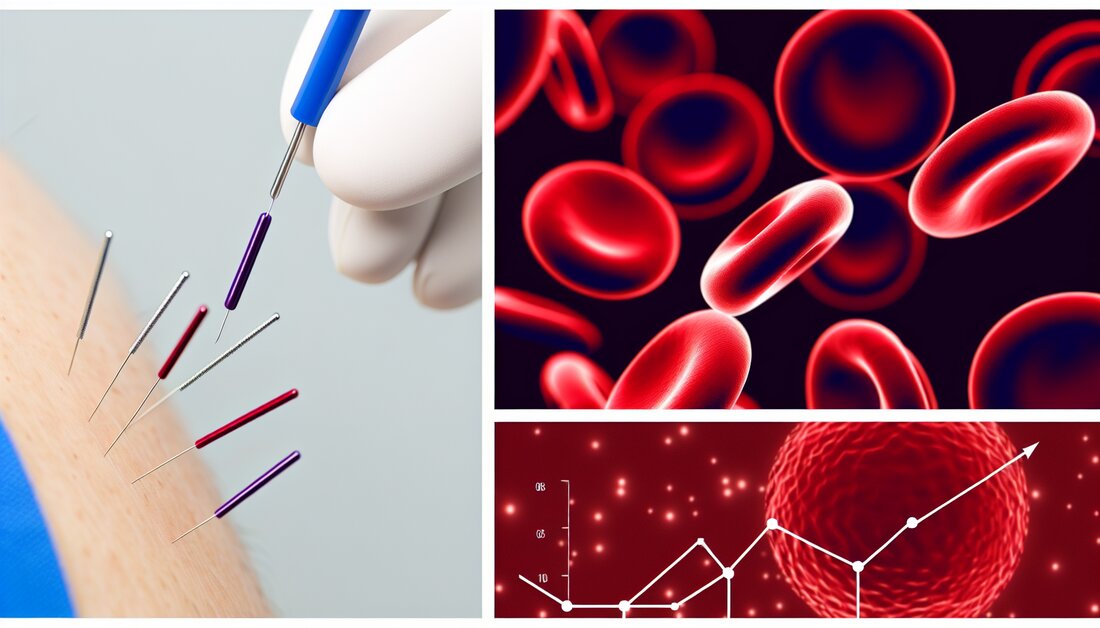Acupuncture miracle: increasing hemoglobin levels in anemia through targeted needling success
Study shows: Acupuncture for IDA at points GB39, BL17, LR13 significantly increases hemoglobin levels and other blood values compared to placebo. Effective treatment method for anemia!

Acupuncture miracle: increasing hemoglobin levels in anemia through targeted needling success
Iron deficiency anemia (IDA) is a common health problem in India characterized by a lack of hemoglobin in the blood. Hemoglobin is a protein in red blood cells that carries oxygen from the lungs to the tissues. One of the possible treatments for IDA is acupuncture, which involves inserting thin needles into specific points on the body to relieve health problems.
A recently published study examined how acupuncture affects women with IDA by placing needles at specific acupuncture points (GB39, BL17, and LR13). These points were chosen because they are traditionally considered effective in treating blood disorders. The research compared a group that received this treatment with a control group that was needled at non-therapeutic points.
The results showed that women who received the acupuncture treatment had a significant improvement in their blood counts, including hemoglobin, mean corpuscular volume (MCV), and red blood cell distribution (RDW). This suggests that acupuncture could be an effective method to treat IDA.
This research could revolutionize the practice of acupuncture for IDA, as traditionally diet or medication have been used primarily for treatment. Future research should focus on understanding the mechanisms behind the observed effects and evaluating the long-term effects of acupuncture on IDA.
To better understand the concepts, here are some basic terms:
- Eisenmangelanämie (IDA): Eine Form der Anämie, bei der das Blut nicht genug rote Blutkörperchen hat, um Sauerstoff effektiv zu transportieren, überwiegend aufgrund eines Eisenmangels.
- Akupunktur: Eine therapeutische Methode aus der traditionellen chinesischen Medizin, bei der feine Nadeln in den Körper eingestochen werden, um die Gesundheit zu fördern oder Krankheiten zu behandeln.
- Hämoglobin: Ein Protein in roten Blutkörperchen, das Sauerstoff im Körper transportiert.
- Mittleres Korpuskuläres Volumen (MCV): Ein Maß für das durchschnittliche Volumen der roten Blutkörperchen.
- Mittlerer Korpuskulärer Hämoglobin (MCH): Die durchschnittliche Menge an Hämoglobin pro rote Blutzelle.
- Red Cell Distribution Width (RDW): Ein Maß für die Variabilität der Größe der roten Blutkörperchen.
Abbreviations:
- IDA: Iron deficiency anemia (Eisenmangelanämie)
- AG: Acupuncture Group (Akupunkturgruppe)
- PCG: Placebo Control Group (Placebo-Kontrollgruppe)
- MCV: Mean Corpuscular Volume
- MCH: Mean Corpuscular Hemoglobin
- RDW: Red Cell Distribution Width
Effective improvement of hemoglobin levels through acupuncture in iron deficiency anemia
The present study investigated the effects of targeted acupuncture on specific hematological parameters in women with iron deficiency anemia (IDA) in India. The study aimed to analyze the influence of acupuncture treatments at GB39, BL17 and LR13 points on hemoglobin levels, mean corpuscular volume (MCV), mean corpuscular hemoglobin (MCH) and red blood cell distribution width (RDW).
Study design and methodology
In a randomized controlled trial, 100 women diagnosed with IDA were divided into two groups: the acupuncture group (AG) and the placebo control group (PCG). The AG received acupuncture treatments at points GB39, BL17 and LR13 for 30 minutes daily over a period of two weeks. In contrast, PCG involved needling at non-acupuncture-specific points.
Results
- Hämoglobinwert: Die AG zeigte einen signifikanten Anstieg von 10,39 g/dl auf 11,38 g/dl (Effektstärke 0,785), während die PCG eine unbedeutende Veränderung von 10,58 g/dl auf 10,40 g/dl aufwies (Effektstärke 0,191).
- Mittleres korpuskuläres Hämoglobin (MCH): In der AG stieg das MCH von 25,69 fl auf 27,50 fl (Effektstärke 0,418); die PCG zeigte dagegen nur eine minimale Veränderung von 27,43 fl auf 27,23 fl (Effektstärke 0,058).
- Verteilungsbreite der Erythrozyten (RDW): Eine Zunahme von 15,12 fl auf 16,41 fl wurde in der AG beobachtet (Effektstärke 0,626), während bei der PCG die Werte nahezu unverändert blieben (14,91 fl zu 14,94 fl, Effektstärke 0,017).
Conclusions
The study suggests that targeted acupuncture at points GB39, BL17 and LR13 may be an effective method for improving blood parameters in women with iron deficiency anemia. The significant improvements in the acupuncture group compared to the placebo group suggest that this form of therapy may play a promising role in the treatment of IDA.
Further research is needed to better understand the long-term effects and potential mechanisms underlying the effectiveness of these acupuncture points. The detailed results and methodological approaches of this study are available at https://pubmed.ncbi.nlm.nih.gov/38115592.

 Suche
Suche
 Mein Konto
Mein Konto
